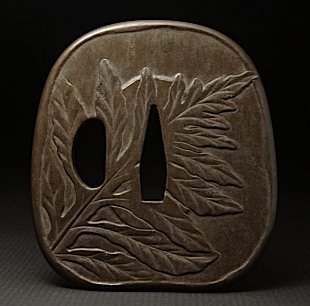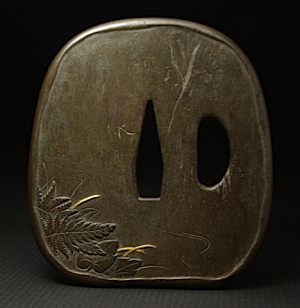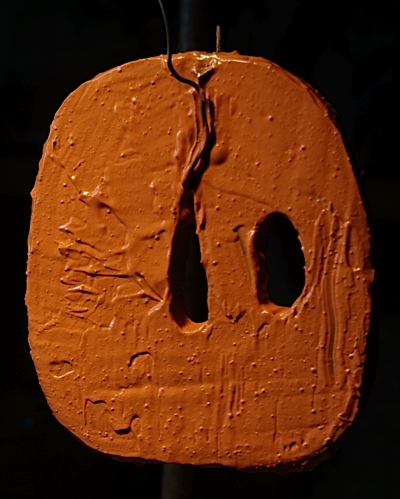| Iron Patina (sabitsuke) Tutorial | ||||
| home Japanese Alloy Basics copyright 2009: Jim Kelso | ||||
| Other Tutorials Recent Works To Archives & Jewelry | ||||
|
||||
There are many formulas for the controlled rusting of iron, both Asian and Western. For this tsuba I used a modified version of a formula I was given in 1997 by my teacher in Osaka, Toshimasa (Sakai Masaichi). I'm not sure where he got it but it is similar to others that show up here and there. The formula I received from Toshimasa-sensei contained arsenic-trisulphide (keikanseki) and I was unwilling to use that one ingredient because of safety reasons, both in handling it and in possibly breathing fumes produced during the drying process. I made extensive tests without the arsenic compound and resolved a version of the formula that reliably produced a Chestnutty brown on the wrought iron I used and was considerably safer to use. I also added extra iron oxide to his formula. The formula from Toshimasa also suggested quantities such as "fistful", " small spoon" and "smaller spoon" which, while extremely helpful, I have, by trial and error, sugared down to conventional metric measurements. I was given a similar formula recently from Professor Yokomizo at the Tokyo University of Fine Arts( Geidai). The document is dated 1933 and she reckons that it came down from Kano Natsuo and Unno Shomin who were active in the late 19th and early 20th centuries, and were the first metalwork professors at Geidai. This formula also contains the arsenical keikanseki but differs in other regards.I had already begun my tests by the time I received this, and feeling allegiance to Toshimasa, I wanted, if possible, to have that formula work out. I tried to reduce the formula to the least number of components possible to keep things simple. I hope to experiment in the future, with other colors in mind, by adding amendments to this basic formula. I had some issues with copper plating at one point and eliminated the copper-sulfate but found that gave no results, so I added it back in a smaller amount which then worked wonderfully. I think the copper flash-plating was also a result of too thick a coat which added to the drying time, leaving a watery medium for plating to take place. Here is the formula I ultimately used: Please note: the user bears all responsibility for the safe use of these materials and to be aware of their potential safety issues. 150 grams kuritsuchii (iron-bearing clay) I used Miller # 75 (WC612) I use distilled water as there can be significant variance in mineral content. First make a paste with the clay and water. I would describe this as a thin yogurt consistency. I came to use thinner coats.The coat as shown below is too thick and took too long to dry, causing cracking and perhaps contributing to copper plating problems. I ended up using a much thinner slip that dried much quicker with just as much rusting effect as the thicker. When the clay/water mix is right, grind the copper-sulfate and saltpetre to a fine powder and mix with the iron oxide and sulphur, which are likely already quite fine. Add a bit of water to the dry chemicals so they go into solution then add to the clay/water. Store in a glass container. The iron must be scrupulously clean. I found with the wrought iron used on this tsuba, that the first coats were critical and that if I wasn't very careful with the cleaning, it was impossible to get a good result. Mild steel probably is less fussy.
|
||||
|
||||


